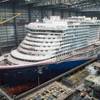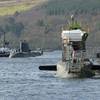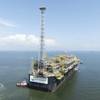MOL commits to Martek BNWAS
Mitsui OSK Line has made a firm commitment to install Bridge Navigational Watch and Alarm Systems (BNWAS) on board its ships ahead of regulatory requirements.
The company has taken the opportunity of the drydocking of 17 of its vessels so far this year to install the Martek Marine Navgard BNWAS. MOL said it was likely that all of its existing vessels would be fitted with BNWAS before the end of 2011. Under the terms of the revised SOLAS regulations new passenger vessels and cargo ships greater than 150gt have had to implement BNWAS since July 2011. However, existing passenger ships and cargo vessels greater than 3,000gt can wait until July 2012 before BNWAS becomes mandatory, while existing cargo ships of between 500gt and 3,000gt can wait until July 2013, and those between 150 and 500gt until July 2014.
Alan Stewart, MOL Tankship Management (Europe) Ltd Deputy General Manager explained that the carrier had already witnessed an increasing frequency of comments by SIRE inspectors regarding whether or not a BNWAS was fitted. He said that MOL had decided on a course of “being proactive and not waiting until the last minute, as is usual in the marine industry”. Martek’s Navgard system was able to demonstrate that it had all necessary approvals, Mr Stewart said, while the company had been able “to solve any challenges that arose”.
The latest deal follows hard on the heels of a contract through which Martek is supplying its Navgard BNWAS to Seacom Electronics, the UK subsidiary of global ship management services giant V.Ships. A number of serious maritime accidents continue to be attributed to issues relating to tiredness, and to the situational awareness of officers on the bridge, leading to widespread calls for owners and operators to act well before they must install BNWAS. The International Chamber of Shipping has carried out a detailed investigation into accident reports in the Malacca Straits which are transited by more than 70,000 vessels each year. It identified ‘loss of situational awareness’ as one of the most significant factors that need to be addressed as a cause of accidents. Of the incidents examined, 68% resulted in collisions and all could have potentially caused harm or pollution incidents.
BIMCO has issued advice to its members urging them to consider fitting systems at drydockings before the mandatory implementation date, and not to wait until annual surveys within the compliance window. A BNWAS monitors bridge activity and detects any operator disability that could lead to shipping accidents. Under revisions to SOLAS, the regulations specify that the system has to be reset either manually or automatically through motion sensor devices at intervals of between three and 12 minutes.
Paul Luen, Martek Chief Executive, said: “There have been a number of incidents recently which show a lot can happen in three minutes, let alone 12 minutes, and so it is vital systems such as Navgard are installed on vessels as soon as possible. Navgard is the world’s first BNWAS system fully type approved by all major classification societies. Owners delaying implementation of BNWAS until the last minute are risking the lives of their crew and the safety of their vessels. Where is the sense in that?” The Navgard system comprises either a bulkhead-mounted or console-mounted control panel with an onboard Passive Infra-Red (PIR) movement detector that offers a 10m range. The system is highly modular, enabling it to accommodate any bridge size and layout. Mr Luen says: “The vessel’s next dry docking is an ideal time to install BNWAS. But, such is the ease of installation of Navgard that the work could be done while alongside or during passage.”















